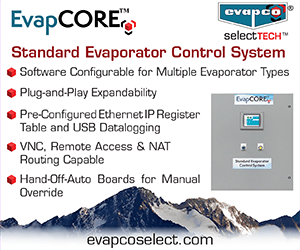From the Technical Director
Ammonia inventory reporting is a necessity, and something that requires a bit of thought and preparation. We have received calls about what form to fill out if a facility has ordered 10,000 lbs. of replacement ammonia. First, there is the yearly inventory reporting requirement under the Emergency Planning and Community Right to Know Act (EPCRA) 312. This includes a Tier I or Tier II (if requested) report to the SERC (state emergency response commission), LEPC (Local Emergency Planning Committee) and the local fire department and must be done by July 1 annually. This report is on your entire inventory. Next, if a facility has received 10,000 lbs of refrigerant for a “re-charge” or “top-off”, it will be considered “otherwise used” under EPCRA 313. Additional conditions of this requirement are that facilities employ 10 or more people, and that the facility is classified as Standard Industrial (this is almost always the case). EPCRA 313 form “R” would be used to report this quantity (the amount added, but not the entire charge) by March 1 for the preceding year.
But when the reporting happens, and the ammonia orders are filled, an obvious question arises…What happened to the refrigerant that was in the system to begin with? This question might not come up immediately upon reporting, but a system manager would do well to figure it out ahead of any regulator that might take a look at the reports or invoices and ask that question. What I am suggesting is that when an annual report is filed, it is not a good idea to repeatedly report the same calculated figure of the inventory year after year and then later order more ammonia to “top off” the system. A savvy inspector would ask the question above, and wonder whether or not there was an unreported major release. So while it is likely an effort in futility to try to calculate exact losses, it is a good idea to make some reasonable estimate of refrigerant that was lost throughout the year and include that loss in annual reports. Typical sources of minor refrigerant loss are: purgers, compressor shaft seals, valve stem packing, oil draining operations, and minor repairs. An often-cited rule of thumb is 5%-10% loss annually of the total system charge, depending upon the age, size and condition of a system. It is worth keeping in mind that losses of 100 lbs. / 24 hours are to be reported to the EPA and the National Response Center. Losses beyond that figure need to be accounted for, whether they are caused by an accidental release, or intentional removal for maintenance or re-configuration.
IIAR will be introducing a newly revised and updated PSM/RMP guidance manual at the IIAR Annual Conference in Milwaukee. One new feature of the guideline is the minor leak reporting program, within the mechanical integrity section. This will help operators keep up with small leaks that do not warrant an immediate shut down, but can be addressed during planned maintenance. This is one means of helping to estimate annual losses so that when inventory reporting comes around, a more accurate accounting can be done and preparation can be made for the justification of adding more refrigerant to your system.












